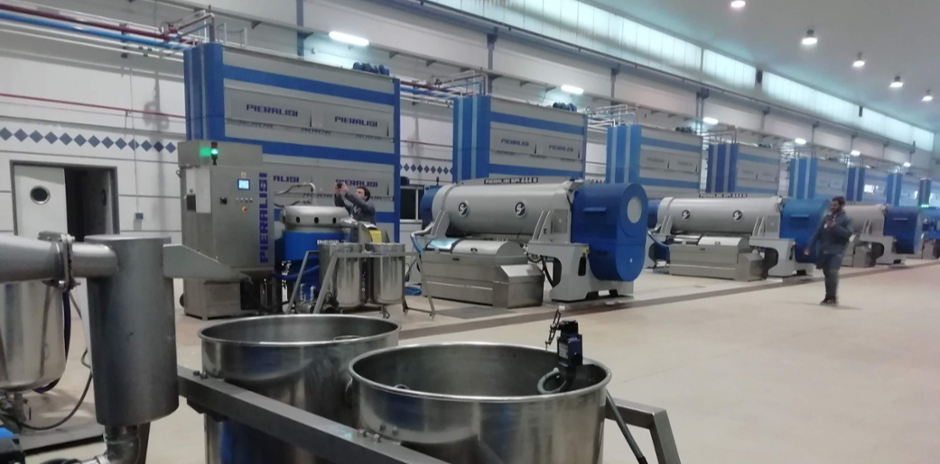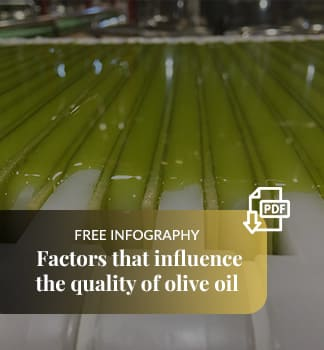Listen to this article
When we speak of an Olive Oil Mill, Almazara in spanish, we refer to the place where the olives are processed to obtain the oil.
As a synonym for Almazara or olive oil mill we have the term factory, as well as some others. In Spain, depending on the geographical area in which we are, the olive oil mill will be named one way or another. For example, in Jaén the term oil factory or almazara is often used, in Córdoba they use more almazara, in the Valencian Community Almàssera, in Catalonia the term Molí is often used, in La Rioja Trujal, for Gerona Trull, and for the area Aragon normally use a mill or oil factory.
The word “Almazara”, which is the most used today in Spain, comes from Arabic. While the term Mill has a Latin origin.
Well, then we already know that the olive oil mill is the place where olives are processed. The person responsible for making the oil is the Master Miller.
Types of oil mill
We can find different types of oil mills, for example:
- Private Olive Oil Mill
It is an oil mill that belongs to a single person or a family. It is a private company.
Private olive oil mills can only process their own olives or they can also process the olives of other people, such as their neighbors or close friends or other producers or farmers who do not have an oil mill and want to bring their olives to make their oil.
This last method of processing olives for other people is called “maquila”. Maquila would therefore be to make the oil to a person who has previously brought their olives to the mill.
The owner of the private oil mill will set his rules, and, for example, he will say that he processes the olives of third parties, but that he needs a minimum quantity X, he will tell you how much he charges you to produce each kilo of olive that you bring him, he will tell you also the time time in which you should bring the olives, and anything he could consider in order to process them.
2. Cooperative Olive Oil Mill
This model of olive oil mill consists of several partners who come together and create a cooperative to grind their olives and make their own virgin olive oil.
Cooperatives are of great importance in Spain, since it is a very widespread model.
Cooperatives can be small, such as 50 members, but also can be formed by thousands of members.
Within the Cooperative model, we find the so-called Second Grade Cooperatives, which in turn would group different cooperatives. With these cooperation systems, large investments can be made in machinery, or in personnel or marketing.
In Spain, there are approximately 1,750 olive oil mills and 950 of these are cooperative olive oil mills.
Fundamental parts of an oil mill
The Oil Mill consists of four fundamental parts:
The reception yard
The reception yard or Backyard
The first part would be the Backyard. The Backyard of an oil mill is the place where the olives enter. If we are talking about a private oil mill, where you only grind your own olives, then you will have a controlled Backyard, where your trailers will enter to deposit the olives.
If it is a cooperative or an oil mill that produces oil in a maquila, it is important that the reception yards are large, and above all that they have entry and exit "lanes". You have to think that the olives are harvested in a short period of time, and because of this, it is easy to queue farmers who want to go to unload their olives, so space in the yard is very important.
ESAO students during the
Master miller course in the Almazara COLIVAL Valdepeñas reception yard, Castilla la Mancha
In the yard we can find installed:
- The hoppers to deposit the olives
- The weighers, to know how many kilos of olives you want to process.
- The conveyor belts that carry the olives from one place to another within the mill.
- The washing machine and destemmer, where the olives will be cleaned
- The mill, where the olives will be crushed. The first step of extracting virgin olive oil.
It is convenient that in the yard the machinery area, at least, is covered.
The Olive Oil mill or factory.
It is the area where the virgin olive oil extraction takes place.
The mill is generally placed in the Backyard mainly because of the noise and heating issues. From the mill, the paste goes into the mill to:
- Malaxer, to knead the paste. The idea is to carry out the coalescence effect and join the small drops of oil into a thicker one and from there to make a conductive thread of the oil. After the Malaxer, we would go to:
- Decanter, this machine, by a centrifugation process, would separate the solid parts from the liquid ones. Generally, the Decanter, through the separation of three rings due to weight difference, will extract on the one hand the oil and on the other hand the solids (pomace) plus the vegetation water. After the Decanter we would go to:
- The vertical centrifuge, which is another machine that will help us to clean the oil from moisture or small particles that it may carry.
Therefore, they are generally three large machines, each with a large number of revolutions.
Once the virgin olive oil has been extracted, it would go to some small tanks or decanters, to later send the oil to the Cellar, to wait for packaging
Cellar
Here you will find the tanks with the oil already stored, and classified according to its quality.
If we have a maquila, at this moment the client who has brought his olives would take the oil corresponding to the batch of olives that he has brought.
Then it can also happen that a client wants us to keep his oil in our oil mill, with which he will rent us a small space where he will have his deposit with his oil.
In the case of cooperatives, the oil is the mixture of all the members' oils, that is, the members carry the olives, and the cooperative will produce the oil based on the union of the olives of all the members without distinction.
It is important that the cellars have a suitable, cool temperature to keep the oils as good as possible. We are talking about a temperature between 18 and 20 degrees.
It is also important that it is isolated, both for aromas and for temperatures.
Good isolation can help keep oils in better condition.
Cooperatives can give the member the corresponding money for the olives that they have brought, or they can pay them with oil, that is, the member can take the number of liters of oil that corresponds to him according to the kilos of olives he has.
Packaging area
After the Cellar, in most cases the oil mills also have a bottling or packaging machine, where the oil that is stored in the tanks would be bottled.
There are, however, many olive oil mills that do not have it and, when they have to pack, they take it to large packers or to third-party packers.
In the packaging machine the label will also be put on the bottle. It is important for the packaging and labeling machine to be as mechanical as possible to minimize possible manual failures.
With this, it is sure that it has become quite clear what an oil mill is. Now all you have to do is locate one and go visit it. We recommend you to visit during the months of October or November (in the northern hemisphere) since at that time it will be in operation and it will smell very good !!
.png)





